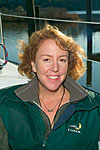Life is learning, and the boating life is no different. It’s remembering to be a student that is sometimes the tricky part. You hop in your runabout or haul on your halyards and off you go, safe and comfortable in the familiar. Then one day, if you’re lucky, something will come along and make you hungry for the unknown.
So it has been for me with my kayak. Boats of all sorts have been part of my life since before I could walk; I don’t know why I came so late to this one. But last summer we started carrying it on Luna, resting it on the side deck between the shrouds and the lifelines like a big blue almond. When the anchor went down, the kayak went in. Paddling away, I would feel like a fledgling osprey leaving the nestopen-winged, open-eyed.
I would find a little creek too shallow for Luna’s deep draft, maybe a creek I’d passed by a hundred times before, and go exploring. Often I would just drift, my little boat skimming slowly on the water in perfect stillness like a piece of goose down, until I would fetch up in some downwind corner of the creek and float there with all the other wind-blown flotsam. In the fall, I was a blue sliver in leafy carpets of gold, red and brown embroidered with acorns, twigs, pieces of reeds and marsh grass, seeds, a blackbird feather, strange, grubby little bubbles, walnutsa whole world there in the leaf wrack.
Then I would paddle off, and maybe I could see oyster shells in the mud below, or leaves suspended just an inch or two beneath the water’s surface, peering upward like the faces of dim ghosts. Old shipwrecked cedars and oaks lay under there too; I would glide over them and see every scarred detail, white flecks of shell jagging out from their dark hulls. There was a whole landscape down there I never knew, and me, flying overhead on the back of a slender blue bird, looking down.
One time I headed out early in the morning to a spot where the land rose up on a bluff topped with trees. On the glassy water, the world doubled itself. The realms of water and sky shifted, taking reality with them. Sitting still in the creek, the depth of the high shoreline’s reflection made me dizzy, and when I started paddling again it seemed I was flying over the tops of the trees.
Yesterday, I headed out again. I wasn’t sure I would make it; the creek was frozen in the morning, and the thin slabs of ice rubbed together in long, jagged stitches, erratically etched like the joint in a skull. By late afternoon, though, the tide was in and the ice was out. As I paddled along, water droplets on my coat sleeve turned to tiny pearls of ice; part of the deck and even the paddle ends were shiny with ice, too. Along the marshy edge, little balls of ice had frozen on nearly every blade of grass just above the waterline, so the whole creek seemed to be wearing a long, beaded necklace. Out by the river, the waves and wind transformed the marsh grass into icy jewels. The afternoon sun glinted through a field of crystal, and what had been a drab, brown landscape was now something out of a fairy tale.
Other than two bald eagles, some buffleheads and a kingfisher, I was the only one there to see it. Three inches off the water, my hand resting on the glassy marsh edge, for a little while I was part of the Bay’s intricate, delicate world, that enormous world you only see when you’re lucky enough to climb into a little boat and remember how to learn.





 Back to School
Back to School